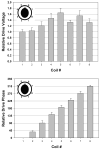Short echo spectroscopic imaging of the human brain at 7T using transceiver arrays
- PMID: 19365851
- PMCID: PMC3675773
- DOI: 10.1002/mrm.21970
Short echo spectroscopic imaging of the human brain at 7T using transceiver arrays
Abstract
Recent advances in magnet technology have enabled the construction of ultrahigh-field magnets (7T and higher) that can accommodate the human head and body. Despite the intrinsic advantages of performing spectroscopic imaging at 7T, increased signal-to-noise ratio (SNR), and spectral resolution, few studies have been reported to date. This limitation is largely due to increased power deposition and B(1) inhomogeneity. To overcome these limitations, we used an 8-channel transceiver array with a short TE (15 ms) spectroscopic imaging sequence. Utilizing phase and amplitude mapping and optimization schemes, the 8-element transceiver array provided both improved efficiency (17% less power for equivalent peak B(1)) and homogeneity (SD(B(1)) = +/-10% versus +/-22%) in comparison to a transverse electromagnetic (TEM) volume coil. To minimize the echo time to measure J-modulating compounds such as glutamate, we developed a short TE sequence utilizing a single-slice selective excitation pulse followed by a broadband semiselective refocusing pulse. Extracerebral lipid resonances were suppressed with an inversion recovery pulse and delay. The short TE sequence enabled visualization of a variety of resonances, including glutamate, in both a control subject and a patient with a Grade II oligodendroglioma.
(c) 2009 Wiley-Liss, Inc.
Figures








References
-
- Robitaille PM, Abduljalil AM, Kangarlu A, Zhang X, Yu Y, Burgess R, Bair S, Noa P, Yang L, Zhu H, Palmer B, Jiang Z, Chakeres DM, Spigos D. Human magnetic resonance imaging at 8 T. NMR Biomed. 1998;11(6):263–265. - PubMed
-
- Vaughan JT, Garwood M, Collins CM, Liu W, DelaBarre L, Adriany G, Andersen P, Merkle H, Goebel R, Smith MB, Ugurbil K. 7T vs. 4T: RF power, homogeneity, and signal-to-noise comparison in head images. Magn Reson Med. 2001;46(1):24–30. - PubMed
-
- Adriany G, Van de Moortele PF, Wiesinger F, Moeller S, Strupp JP, Andersen P, Snyder C, Zhang X, Chen W, Pruessmann KP, Boesiger P, Vaughan T, Ugurbil K. Transmit and receive transmission line arrays for 7 Tesla parallel imaging. Magn Reson Med. 2005;53(2):434–445. - PubMed
-
- Adriany G, Van de Moortele PF, Ritter J, Moeller S, Auerbach EJ, Akgun C, Snyder CJ, Vaughan T, Ugurbil K. A geometrically adjustable 16-channel transmit/receive transmission line array for improved RF efficiency and parallel imaging performance at 7 Tesla. Magn Reson Med. 2008;59(3):590–597. - PubMed
Publication types
MeSH terms
Substances
Grants and funding
LinkOut - more resources
Full Text Sources
Other Literature Sources
Medical

